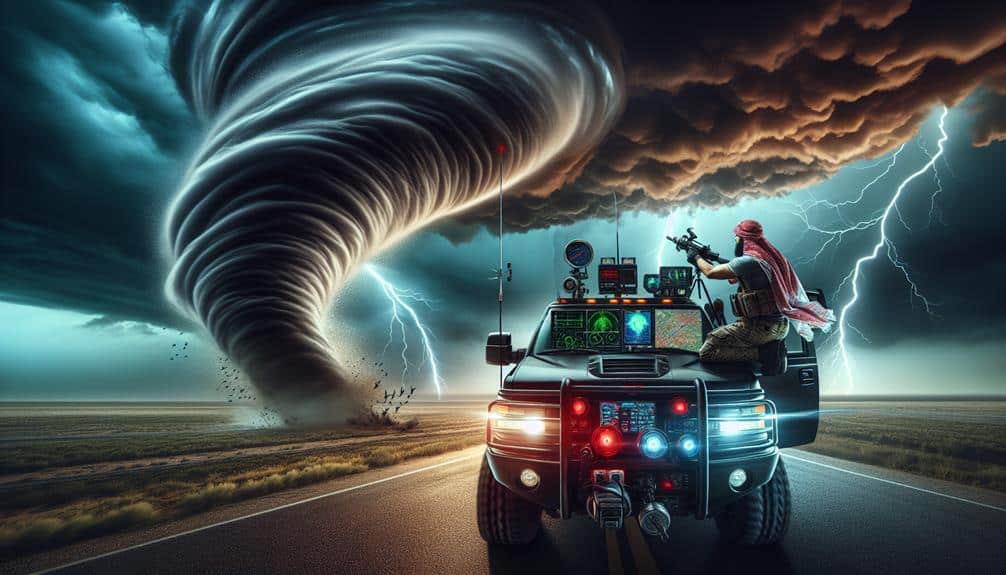To optimize storm chasing, we should start by carefully analyzing past storm patterns to recognize seasonal trends and refine our tracking parameters. Utilizing historical weather databases lets us visualize data, identify climatological trends, and guarantee reliability. Implementing predictive models is essential as it integrates historical data with real-time observations, improving forecasting accuracy. These models benefit from rigorous data preprocessing and validation techniques like cross-validation. Together, these practices greatly enhance our ability to anticipate storm behavior. By focusing on these key strategies, we're better equipped to understand storm dynamics and refine our approach further.
Key Points
- Ensure data accuracy and reliability by cross-referencing multiple historical weather databases.
- Preprocess and standardize datasets to maintain consistency and quality in predictive models.
- Visualize data to identify climatological trends and improve storm behavior anticipation.
- Validate predictive models with historical data using techniques like cross-validation for robustness.
Analyze Past Storm Patterns
By delving into historical storm data, we can identify recurring patterns that enhance our predictive capabilities for future storm events. Analyzing past storm patterns enables us to discern significant weather trends, which are vital for effective storm tracking. This process entails a systematic examination of variables such as storm frequency, intensity, and trajectory over time.
First, we aggregate extensive datasets from past storms. By meticulously plotting these data points, we observe clusters and anomalies that reveal underlying weather trends. For instance, certain regions may exhibit higher storm activity during specific seasons. Recognizing these patterns allows us to anticipate future events with greater accuracy.
Next, we employ statistical models to quantify the likelihood of storm occurrences based on historical data. These models incorporate variables like atmospheric pressure, humidity levels, and temperature gradients. By refining these parameters, we improve our storm tracking precision, which is crucial for timely warnings and risk mitigation.
Moreover, historical analysis helps us understand the evolution of storm behavior due to climate change. By comparing past and present data, we can identify shifts in storm patterns, enabling proactive adjustments in our forecasting methods. Through this rigorous analytical approach, we empower ourselves with the knowledge to navigate future storm events more effectively.
Utilize Historical Weather Databases
Harnessing historical weather databases provides us with the detailed, long-term data necessary to refine our storm prediction models. These databases offer a wealth of information, allowing us to analyze climatological trends and enhance our understanding of severe weather patterns. By utilizing these resources, we can make more informed decisions and improve our storm chasing strategies.
To maximize the benefits of historical weather databases, we should focus on the following aspects:
- Data visualization: Leveraging advanced tools to create clear, insightful visual representations of weather data.
- Climatological trends: Identifying long-term patterns to anticipate future storm behavior.
- Data accuracy: Ensuring the reliability and precision of the historical data we use.
- Temporal resolution: Examining data at different time scales, from annual trends to minute-by-minute observations.
Implement Predictive Models
To implement predictive models effectively, we must integrate historical data with real-time observations to accurately forecast storm development and behavior. This integration requires meticulous data preprocessing to clean and standardize diverse datasets. By eliminating noise and ensuring compatibility, we enhance the model's accuracy and robustness.
Our first step involves curating historical data, including temperature, humidity, wind patterns, and past storm paths. We combine these with live data feeds from weather stations, satellites, and radar. This extensive dataset forms the foundation of our predictive models.
Next, we focus on model validation. We split our data into training and testing sets, ensuring that our model learns from a diverse range of scenarios. Using techniques like cross-validation, we verify our model's performance across different subsets of data. This rigorous validation process helps us identify potential weaknesses and refine the model for better reliability.
Frequently Asked Questions
How Can Social Media Be Used for Real-Time Storm Tracking?
Did you know 70% of storm-related deaths are preventable? We can harness social media for real-time storm tracking through data visualization and emergency alerts, maximizing our freedom by ensuring timely, accurate updates for better decision-making.
What Are the Legal Considerations for Storm Chasers?
We need to respect privacy rights and be cautious with data collection. Liability concerns are paramount; we must guarantee appropriate insurance requirements are met to minimize risks and protect ourselves legally while chasing storms.
How Do You Ensure the Safety of Storm Chasing Teams?
When we chased a supercell in Oklahoma, we used real-time weather forecasting and risk assessment. Effective team communication and strict emergency protocols guaranteed everyone's safety, allowing us to experience the storm's power without compromising our freedom.
What Equipment Is Essential for Storm Chasing?
To answer the current question, we need essential equipment like camera gear for documentation, communication devices for coordination, GPS trackers for navigation, and weather stations for real-time data. Let's make sure we're well-prepared and free to chase safely.
How Can Amateur Storm Chasers Contribute to Scientific Research?
As amateur storm chasers, we can contribute to scientific research through citizen science. By engaging in precise data collection and fostering research collaboration, we provide valuable insights that enhance understanding of storm patterns and behaviors.


